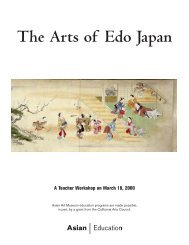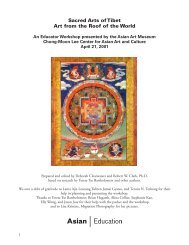Teacher Packet: Chinese Brushpainting (.pdf) - Asian Art Museum ...
Teacher Packet: Chinese Brushpainting (.pdf) - Asian Art Museum ...
Teacher Packet: Chinese Brushpainting (.pdf) - Asian Art Museum ...
Create successful ePaper yourself
Turn your PDF publications into a flip-book with our unique Google optimized e-Paper software.
Slide 3<br />
Brushstrokes: Styles and Techniques of <strong>Chinese</strong> Painting<br />
The Four Treasures and Other Utensils for a Scholar’s Desk<br />
Writing was so valued by the <strong>Chinese</strong> that they called the most essential implements for the art The<br />
Four Treasures -- the brush, ink stick, ink stone, and paper. Here is shown a fancy, jade-handled<br />
brush, a small stick of ink resting on the edge of the rectangular ink stone, and a roll of paper<br />
with a section stretched out and held flat with weights. These tools were used by both painters<br />
and calligraphers.<br />
The <strong>Chinese</strong> brush is very flexible and versatile. It comes to a fine point so that it can produce very<br />
thin lines, but it is also fat enough to make wider lines and dots which was useful in writing characters<br />
as well as in painting. The ink did not come in liquid form but rather as a cake or stick which<br />
had to be ground with water just before it was to be used. So then the ink stone on which the<br />
ink was ground was also an essential tool for the writer or painter. Paper, which was invented in<br />
China around 100 B.C.E., was originally used only for writing, later became the favorite ground<br />
for scholar’s painting.<br />
Other objects in this picture include (from left to right) a brush holder with brushes of different sizes<br />
and stiffnesses, a small green bowl for washing brushes, a water dropper in the shape of a fish, a<br />
blue-and-white porcelain brush rest in the shape of a mountain, a pair of carved seals and a container<br />
of red seal paste. To use the ink and brush, artists or calligraphers needed all these tools. Some were<br />
designed to hold or pour water in order to grind and dissolve the ink stick, to rinse the brushes, and<br />
to make different tones by diluting the ink. When a painting or piece of calligraphy was finished, the<br />
artist would sign it and stamp one or more seals beneath the signature. A pair of carved seals and a<br />
container of red seal paste are in the right foreground. Having beautiful tools for painting was not just<br />
a pleasure in itself, it also indicated a respect for the art of painting and calligraphy. Consequently,<br />
beautiful containers of ceramic, jade, bamboo, lacquer, or metal were created specifically for use in<br />
painting and writing.<br />
3 <strong>Asian</strong> <strong>Art</strong> <strong>Museum</strong>
















